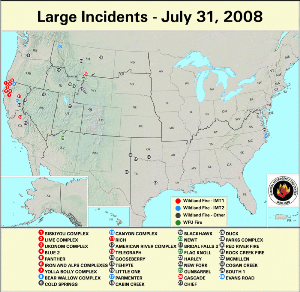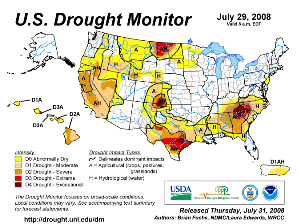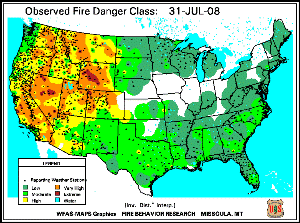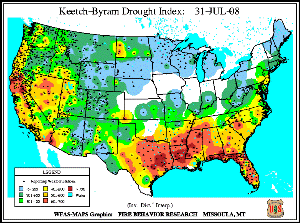July began with a number of wildfires in 12 states, most notably California and Arizona. By the middle of the month, most of the fires in the Appalachians and the Southwest U.S. had been contained. Unfortunately, a spate of large wildfires developed across central and eastern Washington state and many of the fires raging across northern California remained largely uncontained. As July came to a close, a dozen large fires continued to burn in northern and central California, while new fires sprang up in Colorado and several other western states. A total of 34 large fires were raging across the United States as of July 31st. According to the National Interagency Fire Center, 2 firefighters lost their lives battling July's wildfires, and Australia and New Zealand have provided 44 fire specialists to assist in containing the fires in California.
According to the U.S. Drought Monitor, drought conditions worsened through July across the north central tier of states — especially across Montana and North Dakota. A slight improvement in conditions during July is noted for southern New Mexico and the southern tip of Texas, primarily as a result of the heavy rains associated with Hurricane Dolly. Over the past 3 months, drought conditions have deteriorated across much of northern and central California as well as parts of the Southeast, and have significantly worsened across east central Texas. At the end of July, extreme to exceptional drought was present in the Smoky Mountains, east central Texas, the western Oklahoma panhandle, and northwestern North Dakota.
As of July 31st, there have been 53,769 wildland fires and more than 3.5 million acres burned so far this year, according to the National Interagency Fire Center (NIFC). This year to date now ranks sixth in quantity of acreage burnt — down from second at the end of May and third at the end of June. Between January 1st and July 31st, both the number of fires and acreage burnt fall near the 1999–2008 average. Five hundred seventy–one large fires have been contained to date in 2008.
Much needed rainfall in June resulted in a reduced fire danger at the end of June. However, that rainfall did not continue into July in some areas, and fire danger had increased across northern and central portions of the western United States by the middle of the month. At the end of July, high to extreme fire danger had greatly expanded across most of the western U.S., according to the U.S. Forest Service (USFS) – Wildland Fire Assessment System.
According to the U.S. Forest Service (USFS) Experimental Fire Potential Index, large portions of the western United States extending eastward to eastern Colorado exhibited a high potential for wildfire activity going into August. Although drought continued to impact the South and southeastern U.S., fire potential remained relatively low in those regions.
2008 Wildfire Statistics
(Source: NIFC)| Year–To–Date Totals as of July 31st | Nationwide Number of Fires | Nationwide Number of Acres Burned |
|---|---|---|
| 7/31/2008 | 53,769 | 3,585,001 |
| 7/31/2007 | 57,017 | 5,046,917 |
| 7/31/2006 | 70,608 | 5,586,914 |
| 7/31/2005 | 38,188 | 4,641,496 |
| 7/31/2004 | 47,529 | 5,484,674 |
| 7/31/2003 | 35,987 | 1,800,473 |
| 7/31/2002 | 52,747 | 4,057,663 |
| 7/31/2001 | 49,885 | 1,531,121 |
| 7/31/2000 | 60,293 | 3,488,932 |
| 5–yr average (2003 – 2007) |
53,422 | 4,869,000 |
| 10–yr average (1999 – 2008) |
52,373 | 3,776,461 |
Dead fuel moisture levels remained critically low across portions of the West and Southwest during July. The 10–hour fuel moisture levels worsened noticeably between July 16th and July 31st over much of the western United States. By the end of July, 10–hour fuel moisture levels had recovered across much of the Mississippi, Missouri and Ohio River basins.
Medium to larger fuels (i.e., see July 31st 100–hr and 1000–hr fuel moistures) continued to be dry across most of the central and western states, while states east of the Mississippi River had relatively high moisture levels.
The Keetch–Byram Drought Index (KBDI), a widely used drought index for fire risk, showed a continuation of fire risk in northern California and Nevada, and a much increased risk of wildfire activity across the Gulf Coast from eastern Texas to the Florida peninsula.
 NOAA's National Centers for Environmental Information
NOAA's National Centers for Environmental Information



